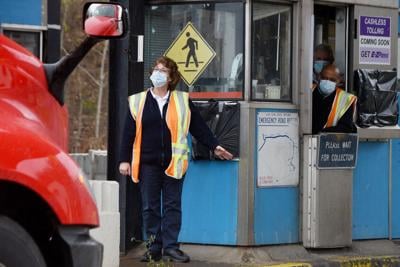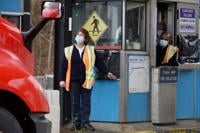ROTTERDAM — As workers on a hoist unbolted the yellow STOP AHEAD GET TICKET sign above the Exit 26 entrance ramp Friday, Thruway employees filtered into the little office alongside to warm their lunches.
Over the radio, the Albany Division toll collectors from Kingston to Canajoharie sounded off on their very last noontime roll call:
“Saugerties East, goodnight sweetheart, well it’s time to go.”
“Canaan, final resting place.”
“Schenectady, last call.”
“Duanesburg, final roll call.”
“Amsterdam, over and out.”
At Exit 26, toll collector Derek Lemon offered a straightforward farewell to his job for the last quarter-century:
“Rotterdam, signing off, last roll call.”
The cash toll-ticket era ended Friday on the New York State Thruway, and with it the steady presence of the men and women who since 1954 were the first, last and sometimes only people motorists would see in their travels along the Thruway.
As of Saturday morning, you pay with E-ZPass or you get a bill in the mail from the Thruway Authority.
As of Monday, all 1,100 toll collectors — 200 full-time, 900 part-time — will move on to a new chapter when their jobs are formally eliminated. A third of the full-timers have retired; the rest will take new jobs with the state or look elsewhere.
One of the longest-serving of these workers is Terrie Fyvie, who started in 1985 as a part-time toll collector in Albany while still in college and ended as a field supervisor of 60 employees from Exits 26 to 29.
As a manager, she’ll be employed until Wednesday, two days longer than her crew. She’ll retire after 35 years in state service, rather than attempting a lateral move to another job.
“I’m going to take the winter off for a change and probably look for something to do in the spring,” Fyvie said Friday in her little office off to the side of the Exit 26 booths.
The Fort Hunter native and Glenville resident is a mother of three with extensive family connections to the Thruway.
Her grandfather helped build it. Her father was a short-order cook at the Pattersonville service area and later he worked in building maintenance. Her brother works in highway maintenance out of Amsterdam. One of her children worked as a part-time toll collector before her nursing career, another is a maintenance supervisor in the Syracuse Division.
When Fyvie went full-time, her first assignment was her most taxing: Exit 16 in Woodbury, a round-trip daily commute of more than 200 miles.
Assignments got closer and technology improved in her 25 years in toll booths. But it remained, essentially, an outdoor job in a region where temperatures can span a 110-degree range.
“Yes, we have heat, but when the doors are open on the booth and you have to collect money, it’s cold,” Fyvie said. “And in the summer it’s hot. Up until a few years ago we did not have any air conditioning in the booths and even that, you’d have to call that more air cooling than air conditioning. It’s definitely not like working an indoor job.”
Fyvie never had a truck hit her booth and seldom encountered verbal abuse, but she’s had her share of stress over the years.
When the Thruway bridge over the Schoharie Creek collapsed in 1987, she was working Exit 28 in Fultonville and assisted with the mass detour of traffic to local roads.
On Sept. 11, 2001, a distraught motorist who worked in the Twin Towers got on in the wrong direction in her rush to get back downstate.
“Myself and my coworker, we were talking to her, trying to get her to calm down enough to be able to turn around without difficulty and head back home,” Fyvie recalled.
Life began for two young passengers at two of the busiest exits in the system while she was working at their toll booths.
“I had a supervisor who did deliver a baby at Exit 24, and there was a co-worker of mine, when I was working at Exit 25, who delivered a baby in the employees’ parking lot,” she said.
She held up traffic once when she spotted a youth who’d fled from a group home. Another time she helped direct police to a disoriented woman reported missing from Florida. That’s Florida the state, not the town in the next county over.
“Toll collectors are not what people think they are,” Fyvie added. “Most people think toll collectors just sit there and hand out tickets and collect change, but toll collectors do a lot more than that. They are looking for missing vulnerable adults, they monitor incidents that occur on the highway, accidents and things like that. Toll personnel are the first people that hear about that.”
That dual role continued right up to the end, though to a lesser degree — motorists have increasingly relied on cellular technology to report problems or get help.
Also, there were gradually fewer toll collectors working to collect less money after E-ZPass was introduced in 1993 — by mid-2020, 79 percent of trips on the Thruway were paid for with the electronic tags.
The $355 million project to replace human toll collectors with electronic scanners and cameras the full length of the Thruway system was finished more than a month ahead of schedule, due in part to lower traffic volumes amid the COVID-19 crisis.
Friday night’s switchover followed 30 continuous days of testing of the new system.
Next up: getting rid of the booths where Fyvie and her colleagues worked.
Signs on the booths reading DON’T STOP that previously were shrouded in black plastic were uncovered Friday night.
The Thruway Authority’s contractor will start removing the booths almost immediately.
Wherever the vacant toll booths still stand, the speed limit through the plaza will be 20 mph. When they’re gone, and after any needed ramp realignments are made to safely allow faster travel at higher speeds, the speed limit will be boosted.
The goal is completion by summer 2021.
All the things that toll collectors once did besides handing out tickets and taking in money — giving directions, calling emergency services, shutting the highway down in weather emergencies — are now in the hands of other Thruway employees, or in the hands of motorists themselves, via the ubiquitous smartphone.
“It’s hard to believe that as of midnight tonight when the last collector comes in out of the lane and they bank out their money, there won’t be anybody else out there,” Fyvie said.









